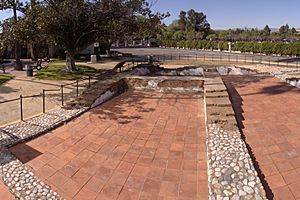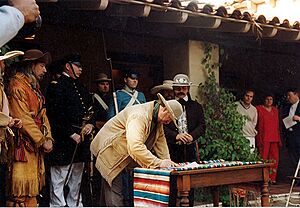Campo de Cahuenga facts for kids
|
Campo de Cahuenga
|
|

Campo de Cahuenga
|
|
| Location | 3919 Lankershim Blvd. Studio City, California 91604 |
|---|---|
| Built | 1847 |
| Architect | Landon and Spencer |
| Architectural style | Mission Revival-Spanish Colonial Revival |
| NRHP reference No. | 72001602 |
Quick facts for kids Significant dates |
|
| Added to NRHP | December 19, 2003 |
Campo de Cahuenga is a special park and building in Studio City, California. It's famous because a very important agreement, called the Treaty of Cahuenga, was signed here in 1847. This treaty helped end a conflict known as the American conquest of California.
The park is located near Cahuenga Pass in the San Fernando Valley of Los Angeles. The building you see today was built in 1950. It helps people learn about the Treaty of Cahuenga. This treaty was signed by Lieutenant Colonel John C. Frémont for the American forces and General Andrés Pico for the Californian forces.
Contents
A Look Back: The History of Campo de Cahuenga
The very first building on this spot was an old adobe house. An adobe is a type of brick made from earth and straw. This original house was taken down in the year 1900.
In 1923, the city of Los Angeles bought the land. Later, in 1950, a new building was constructed. It looks like the old Spanish-style ranch houses. This new building was created thanks to efforts led by Irene T. Lindsay, who was the president of the San Fernando Valley Historical Society.
Today, Campo de Cahuenga is a park and a learning center. The City of Los Angeles's Department of Recreation and Parks manages it. They work with the Campo de Cahuenga Historical Memorial Association.
Important Historical Site Designations
Campo de Cahuenga is recognized as a very important historical place. It is listed on the National Register of Historic Places. It is also known as California Historical Landmark No. 151 and Los Angeles Historic-Cultural Monument No. 29. These titles show how important the site is to history.
Discovering the Original Foundations
During the construction of the Metro B Line subway, workers found something amazing. They uncovered the foundations of the original adobe house! These foundations were hidden beneath Lankershim Boulevard.
The parts of the foundations that are inside the park are now preserved. You can see them as an exhibit. The "footprint" of the foundations that are under the street and sidewalk is marked with special pavement. This helps people imagine where the old house once stood.
Visiting Campo de Cahuenga
The building at Campo de Cahuenga is used by different groups for special events and meetings. You can visit the park and learning center with a guide on the first Saturday of each month. It is open from 12:00 PM to 4:00 PM.
California Historical Landmark: What the Marker Says
There is a special marker at Campo de Cahuenga. It is California Historical Landmark Marker No. 151. This marker tells us about the history of the site.
It says:
- NO. 151 CAMPO DE CAHUENGA - 'Here was made the Treaty of Cahuenga by General Andrés Pico, commanding forces for Mexico, and Lieutenant-Colonel J. C. Frémont, U.S. Army, for the United States. By this treaty, agreed upon January 13th, 1847, the United States acquired California - finally secured to us by the treaty of Guadalupe Hidalgo, made February 2nd, 1848.' This legend was written February 9, 1898 by Mrs. Jessie Benton Frémont.
This marker explains that the Treaty of Cahuenga was signed here on January 13, 1847. This treaty was a big step in the United States gaining control of California. The deal was made final later with the Treaty of Guadalupe Hidalgo in 1848.
Images for kids
See also
- Battle of Cahuenga Pass – 1831
- Conquest of California – 1846 Alta California
- Cahuenga, California; Tongva settlement.
- Tongva—Tongva language
- History of California through 1899
- History of the San Fernando Valley to 1915
- List of Los Angeles Historic-Cultural Monuments in the San Fernando Valley
- List of Registered Historic Places in Los Angeles








